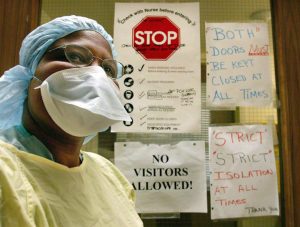
The news nearly killed my mother. I believe that it hastened my father’s death. In February 2003, my father suffered a debilitating stroke that stole his two most precious faculties – speech and memory. Because my parents lived in Agincourt, paramedics rushed him to Scarborough Grace Hospital.
Days later SARS struck the same floor of the hospital where my father was recovering. Nevertheless, nurses told us they could isolate Dad sufficiently so that Mom could still suit up with PPE and see him. But then the Conservative provincial government, thinking it knew better than the health-care specialists, intervened.
“For his safety,” they told my mother, “we’re isolating your father in the new PPP (public-private partnership) hospital in Brampton.”
“How is my mother, living in Agincourt, going to be able to see my father in Brampton?” I asked the office of then health minister Tony Clement.
“She can communicate with him by fax,” they recommended.
First, the minister’s office had paid no attention to what then Ontario Chief Medical Officer of Health, Sheela Basrur said publicly – that Grace Hospital doctors and nurses had contained SARS to one ward inside the hospital.
Second, they hauled my father so far from my mother – to the opposite side of the GTA – she couldn’t possibly attend him.
And finally, they recommended we use a paper fax to communicate with a patient who could no longer read, speak or remember what happened three seconds ago. Dad died 11 months later.
They didn’t use the term back in 2003-04, but these days – with our hospitals facing insufficient beds due to pressure from COVID, nurse and doctor burnout, and hours-long waits for services in Ontario hospitals – patients occupying beds awaiting treatment or recovering but unable to be released are known as “bed blockers.”
The term emerged four years ago, when CBC used Freedom of Information Act legislation to investigate delays in bed availability at London (Ontario’s) Health Science Centre. In his story, reporter Colin Butler learned that from 2014 to 2017, LHSC discharged 5,569 alternate-level-of-care patients who’d spent in total 108,688 days in hospital beds. That’s accumulatively 298 years. In one case, a patient spent 929 days (two and a half years) before being discharged to a nursing home in 2015.
“It’s become our reality,” one nurse told Butler. “Some of the funding decisions and cuts have been catastrophic.”
As a response to part of this problem, the current provincial government announced last week what it calls a new phase of its “Plan to Stay Open” policy for health care. Among its planks for recovery, Ontario Health will allow senior patients in hospital waiting for placement in a long-term care home to be transferred to an alternative facility.
That means the government could move her/him to a different community (i.e. from Scarborough to Brampton) until a preferred spot becomes available. In making the announcement, Minister of Long-Term Care Paul Calandra said last Thursday:
“There are those patients who doctors say no longer need to be in a hospital, but can’t go home either. Amendments if passed will make it easier to temporarily transition these patients into a long-term care home.”
Echoing Calandra’s “Stay Open” amendment, Sylvia Jones, the minister of health told delegates to the Association of Municipalities the same day in Ottawa, “After decades of inaction, we can no longer stand by and support a status quo.”
In effect, she said her government’s innovation was to relieve Ontario’s overburdened health-care system by moving elderly hospital patients to nursing facilities in other locales.
In fact, the government doesn’t need a new amendment, nor a fancy new name. In April 2021, during the third wave of the pandemic, Ford’s government voted in an amendment to the Emergency Management and Civil Protection Act.
That amendment gave the government the power to transfer ill hospital patients without their consent or the consent of a decision maker. For some patients that would mean transfer from the public health-care system unilaterally into (in some cases) privately operated long-term care facilities.
“Guided by the best evidence … the government will take bold action,” Minister Jones told municipal delegates.
My own experience attempting to advocate for a sick parent tells me otherwise. I tend to agree with some critics who call the Conservative government’s so-called “bold action” a code phrase for cutting publicly funded services and farming them out to private clinics and nursing homes whose primary objectives are profits and dividends to shareholders.
My father was not a bed blocker, nor are the estimated 2,000 people in Ontario hospitals awaiting transfer to publicly run long-term-care homes. They and their families need the assurance that recovery or sustained health rests in the hands of professionals monitoring vital signs, not bottom lines.